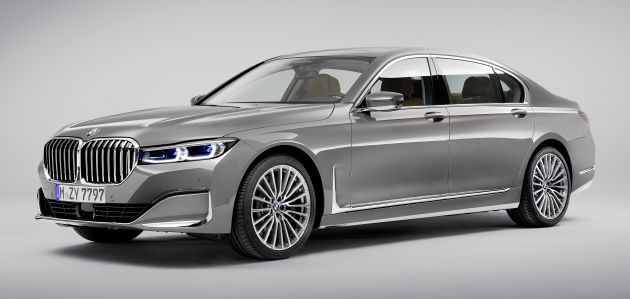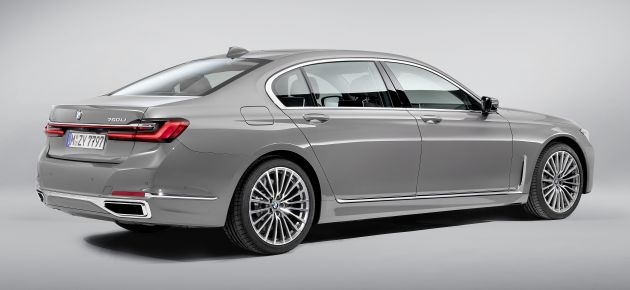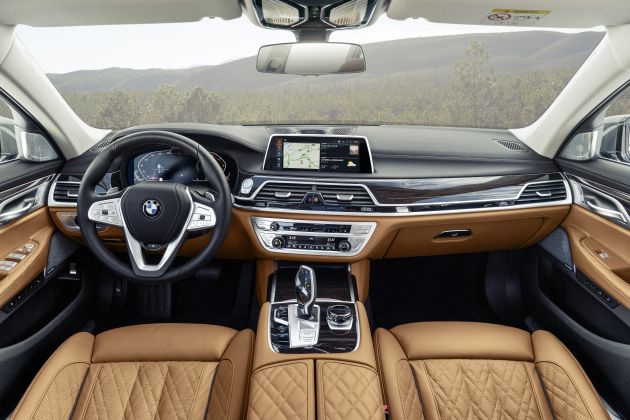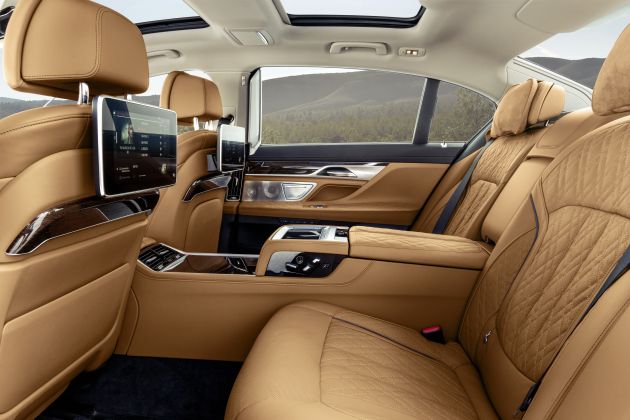BMW has officially unveiled the new G11/G12 7 Series LCI (facelift in BMW speak) to ensure that its ongoing war against the Mercedes-Benz S-Class and Audi A8 may continue further. Aside from styling revisions, BMW’s flagship sedan also gets a number of powertrain and technology updates, as you’d expect.
One of the easiest ways to spot the new 7 Series is by looking at its face, where you’ll find a redesigned kidney grille that is not only a single-piece item this time round, but also 40% larger than before. A consequence of the new grille is the front of the car now rises around 50 mm taller at its foremost point.
Slim headlamps flank the new nose, with Adaptive LED Headlights technology coming as standard – Laserlight is available as an option. Other changes include a new bonnet with more prominent contour lines, a larger BMW badge and a revised lower apron.
Touching upon the last item, the outer air intakes now feature air deflectors to better guide air to the brake air ducts and the Air Curtains. Cars with the M Sport package substitute these for wide-open air intake instead.
Along the sides, BMW has fitted upright Air Breathers that appear more discreet and help to optimise airflow through the wheel arches. Though not observable, improvements have also been made to lower NVH, with side windows that are 5.1 mm thicker and more acoustic insulation around the rear wheels. Of a smaller note, both versions of the new car are 22 mm longer than the pre-LCI models, with no change in wheelbase – standard (3,070 mm), LWB (3,210 mm).
Unlike the front, the new 7 Series’ rear remains familiar to the eye, with noticeable changes being the new taillights that incorporate the carmaker’s L-shaped signature. BMW also points out that the clusters are 35 mm slimmer than before, and there’s a full-width light strip below the chrome bar, which is linked to the daytime driving lights. Further down, the trim accompanying the exhaust outlets is now wider.
A selection of exterior paint finishes is also available, with two non-metallic and eleven metallic finishes to choose from. Splurge a little more and you can opt for one of twelve BMW Individual options for more visual impact. On a related note, BMW offers wheels ranging from the 17 to 21 inches in size, with different finishes.
Moving inside, the new 7 Series now comes with Live Cockpit Professional and Operating System 7.0 (with Intelligent Personal Assistant), as you’d find from recent BMW models as well. There’s also a new steering wheel lifted from the X7 and new interior trim strips but beyond that, the rest of the controls like the gear lever and iDrive dial/buttons look unchanged from before.
In other areas, there’s a wireless phone charger fitted as standard equipment and the ambient lighting system has been updated. Customers will also get plenty of options to choose from, be it different leather upholsteries, trim packages, Executive Lounge setup, M Sport package and rear-seat entertainment (two 10-inch displays) being just some of them.
Standard safety and driver assistance systems that are present on the new 7 Series include the Driving Assistant and Parking Assistant packages, with Driving Assistant Professional and Parking Assistant Plus available as an option. Also available is a heads-up display and Night Vision system.
Engine options available at launch include a range of petrol, petrol plug-in hybrid and diesel powertrains, with most of them being available for standard- and long-wheelbase models (denoted by an ‘L’). The Euro 6d-TEMP engines come with an eight-speed Steptronic automatic transmission as standard; with BMW’s fully variable xDrive all-wheel drive system also present on selected variants.
Two conventional petrol engines are listed, with the first being a N63B44T3 4.4 litre twin-turbo V8 (also found in the new 8 Series) that makes 530 PS and 750 Nm of torque in the 750i xDrive and 750Li xDrive. In terms of performance, the 0-100 km/h time is as low as four seconds on the standard-wheelbase and 4.1 seconds on the Li version.
The other powerplant is found in the M760Li xDrive, and it is a 6.6 litre twin-turbo V12 with 585 PS and 850 Nm, which allows for a century sprint of 3.8 seconds.
As for the diesel options, a 3.0 litre turbocharged straight-six with 265 PS and 620 Nm is found in the 730d, 730Ld, 730d xDrive and 730Ld xDrive. Moving further up, there’s the 740d xDrive and 740Ld xDrive, both featuring a 3.0 litre multi-stage turbo in-line six with 320 PS and 680 Nm.
The last of the diesel engines available is a 3.0 litre quad-turbo in-line six that makes 400 PS and 760 Nm, which powers the 750d xDrive and 750Ld xDrive.
The plug-in hybrid powertrain used in the 745e, 745Le and 745Le xDrive is new, and is based on a 3.0 litre turbocharged straight-six engine with 286 PS and 450 Nm. This differs from what is found in the pre-LCI 740Le we have here, which employs a 2.0 litre turbo four-pot instead.
The mill is augmented by a 113 PS/265 Nm electric motor that is integrated into the Steptronic gearbox, doing double duty to provide drive and acting as a generator to recuperate energy for the high-voltage, 12 kWh lithium-ion battery placed underneath the rear seats. According to BMW, a full charge when plugged into a 3.7 kW charger (16 A/230 V) will take approximately 4.4 hours.
Taken as a whole, the hybrid powertrain delivers 394 PS and 600 Nm, allowing for a 0-100 km/h time of 5.1 seconds. The top speed is 250 km/h (applies to all engines mentioned here), or 140 km/h when running only on electricity. Should you choose to run with emissions, the electric range is up to 54 km.
All variants of the 7 Series come as standard with adaptive suspension including electronically controlled dampers and two-axle air suspension with automatic self-levelling. Pay more, and you’ll even get rear-wheel steering as part of the Integral Active Steering system, or active roll stabilisation with Executive Drive Pro (not available for PHEV versions).
As before, drivers will have access to the Driving Experience Control switch located just beside the gear lever, allowing them to swap between different drive modes affecting the powertrain, suspension and steering.
Source: Read Full Article





